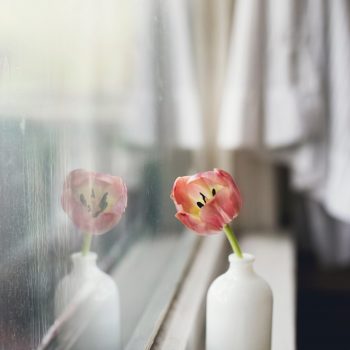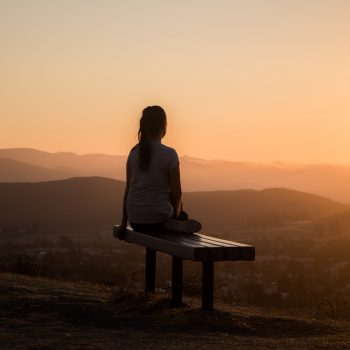The Moment I Knew Gratitude is the Answer to Every Question
"We can’t change the past losses, but we can change the way in which we relate to our losses, and for this I am infinitely grateful."
It’s October 2007, and it is pitch black outside. The birds are not even awake, and I’m rumbling through my purse, going to turn on the car, to make sure the seat warmer on the passenger side is on because my husband’s frail and skinny body gets cold easily. I’m going through a mental checklist: grab snacks, bottle of water, cash. I go back into the kitchen.

My husband Roy is up and ready. I see the clothes are loose fitting, kind of hanging on him, but he still looks healthy in so many ways. I grab his favorite jacket, and we walk downstairs to the car. He mumbles, “Grateful I can still walk short distances like this.” I ignore it. I’m more focused on driving to Ann Arbor.
At this time of the morning, there is no traffic. During the car ride, we make small talk. I pull into the University of Michigan Cancer Center parking lot. I remark that I’ve never seen it so empty. We don’t have a handicap sticker yet because the cancer diagnosis happened about three weeks ago, and we’re still in crisis mode. I park in the closest non-handicap parking spot.
Getting out of the car, I notice a cluster of wheelchairs together, like you’d find a bunch of shopping carts all together at the grocery store parking lot. I try to find the best one. I realize they’re all in the same condition, and I push it over. Like it is an old habit, we do the transfer from car to wheelchair. We wonder aloud if we can get into the building this early. No one seems to be around, but we enter.
"I catch the mom’s eyes, and she gives me a glance of understanding."
As I push the elevator arrow button, a woman walks towards us, with her husband. He is pushing a wheelchair with an IV station (also on wheels) and a very young bald male child is sitting in it, no hospital gown, reading a book. I notice his backpack is securely fastened to the back of the wheelchair. I don’t want to stare, even if we weren’t in the Cancer Center, I know I shouldn’t give them a second look. I’m not sure where to look. I catch the mom’s eyes, and she gives me a glance of understanding.
The elevator doors open. I’m uncomfortable so I look away at the dad who’s been tasked with managing the IV and pushing his son’s wheelchair into the elevator. I tell my husband, “We’ll wait.” They overhear me and say, “No, there’s plenty of room.” The mother extends her arm to make sure the doors stay open. Now the five of us ride in this elevator. Silence. We all exit, and I see them wander off in another direction.
Now, I’m actually staring because their backs are to me. I wonder, “What type of cancer does this child have? Is it treatable? How long have they been coming to the cancer center? What grade is he in?”
"My heart is racing, and there are tears coming down my face. I’m crying for this family, for this child, complete strangers and yet, it also is giving me permission to cry for Roy and myself."
I feel my chest slightly tighten with a lump in my throat. I tell Roy, I need to use the bathroom. I push his wheelchair off to the side. I can’t get into the bathroom stall fast enough. My heart is racing, and there are tears coming down my face. I’m crying for this family, for this child, complete strangers and yet, it also is giving me permission to cry for Roy and myself. I try the deep breathing. I panic, wondering how long I’ve been in this stall. I go to the sink, and begin to assess the damage. “Will he be able to tell I’m crying?”

I don’t recognize this face staring back at me. Then I look at my hair; it’s a rat’s nest. I wonder, “did I forget to brush it?” I tell myself, “Pull it together. No one is looking at your hair.” I walk out of the bathroom, trying not to make eye contact with Roy, pretending to look for directive signage. He can’t see me now because I’m pushing him down the hall, yet, somehow he knows I had a meltdown. He says, “Seeing that little guy reminds me how much we have to be grateful for, doesn’t it?”
I want to stop the wheelchair and just lay face down somewhere and cry. I can’t allow myself that moment here. I need to get him to this appointment. I keep pushing the wheelchair, trying to take deep breaths without being obvious. He repeats, “We have so much to be grateful for, don’t we?” This time, the tone is more declarative, using his middle school teacher voice, not really asking a question. I’m choking back tears, searching for words. I’m actually speechless. Impulsively, I blurt this out, “What do you mean?”
"It feels like my heart is literally breaking open."
Now, I actually stop the wheelchair, pushing it up to a round table, and I sit down. There are more people around, but it still feels like time stopped. I’m thinking about the pain, the disappointment that the cancer diagnosis is terminal, and it feels like my heart is literally breaking open.
Roy doesn’t miss a beat, and begins to make a gratitude list (we began exchanging gratitude lists in 2002): “Look at this great place we are at. They (the staff) got us in before everyone else this morning, you’ve really learned how to navigate your way around this place.” He grabs my hand and adds, “We have each other.”
That moment was in October 2007, and when I think back to this moment, my eyes still fill with tears. In less than eight weeks, Roy underwent numerous medical procedures, consultations and then we made the decision for hospice. He died at home in November 2007, about eight weeks after the initial cancer diagnosis.
"My life changed because of his death and because of my husband’s beautiful acceptance of his death."

My life changed because of his death, and because of my husband’s beautiful acceptance of his death. I co- wrote the book “A Widow’s Guide to Healing“, with psychologist James Windell, for other widows. Over 100 widows were interviewed for this book, and their narratives were put together, along with advice from experts, in this book.
Since the book’s publication I’ve spoken with widows and those in bereavement about their experiences. When I listen to them, I often, can’t help thinking back to those brutal months in 2007. I felt isolation, even around others, and loneliness aside from grief — the kind of sorrow the bereaved share.
I am here to share with you that healing is possible. It happens in small micro-moments, but those moments add up. We can’t change the past losses, but we can change the way in which we relate to our losses, and for this I am infinitely grateful.
This article is printed here with permission. It originally appeared on Gratefulness, the online magazine of the A Network for Grateful Living. This is a global organization offering online and community-based educational programs and practices which inspire and guide a commitment to grateful living, and catalyze the transformative power of personal and societal responsibility.
Kristin A. Meekhof is an author, speaker, writer, blogger, resilience/lifestyle coach, avid runner, and a licensed social worker. A nationally recognized expert on resiliency and gratitude, her best-selling book, A Widow’s Guide to Healing, was inspired by her own personal experience with widowhood, grief, and healing.


On Jul 11, 2018 Pete Wainscott wrote:
Thank you...heartfelt.
Post Your Reply